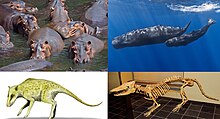
Back حيتانيات وفرسيات النهر Arabic Whippomorfs Catalan Whippomorpha Czech Whippomorpha Spanish Whippomorpha Basque نهنگاسبآبیریختان Persian Whippomorpha French דמויי היפופוטם HE Whippomorpha ID 鯨河馬形類 Japanese
| Whippomorpha Temporal range:
| |
|---|---|

| |
| Scientific classification | |
| Domain: | Eukaryota |
| Kingdom: | Animalia |
| Phylum: | Chordata |
| Class: | Mammalia |
| Order: | Artiodactyla |
| Clade: | Cetancodontamorpha |
| Suborder: | Whippomorpha Waddell et al. 1999 |
| Subgroups | |
| |
Whippomorpha or Cetancodonta is a group of artiodactyls that contains all living cetaceans (whales, dolphins, and porpoises) and the hippopotamids.[1] All whippomorphs are descendants of the last common ancestor of Hippopotamus amphibius and Tursiops truncatus. This makes it a crown group.[2] Whippomorpha is a suborder within the order Artiodactyla (even-toed ungulates). The placement of Whippomorpha within Artiodactyla is a matter of some contention, as hippopotamuses were previously considered to be more closely related to Suidae (pigs) and Tayassuidae (peccaries).[3][4] Most contemporary scientific phylogenetic and morphological research studies link hippopotamuses with cetaceans, and genetic evidence has overwhelmingly supported an evolutionary relationship between Hippopotamidae and Cetacea.[5] Modern whippomorphs all share a number of behavioural and physiological traits; such as a dense layer of subcutaneous fat and largely hairless bodies. They exhibit amphibious and aquatic behaviors and possess similar auditory structures.
Whippomorpha is a subgroup of Cetancodontamorpha, which also includes the extinct entelodonts and Andrewsarchus.
- ^ Joeckel, R. M. (1990). "A functional interpretation of the masticatory system and paleoecology of entelodonts". Paleobiology. 16 (4): 459–482. Bibcode:1990Pbio...16..459J. doi:10.1017/S0094837300010198. S2CID 88949308.
- ^ Waddell, P. J.; Okada, N.; Hasegawa, M. (1999). "Towards resolving the interordinal relationships of placental mammals". Systematic Biology. 48 (1): 1–5. doi:10.1093/sysbio/48.1.1. JSTOR 2585262. PMID 12078634.
- ^ Beck, Robin M.D.; Bininda-Emonds, Olaf R.P.; Cardillo, Marcel; Liu, Fu-Guo; Purvis, Andy (2006). "A higher-level MRP supertree of placental mammals". BMC Evolutionary Biology. 6: 93. doi:10.1186/1471-2148-6-93. PMC 1654192. PMID 17101039.
- ^ Black, Riley. "How Did Whales Evolve?". Smithsonian Magazine. Retrieved 2020-11-04.
- ^ Tsagkogeorga, Georgia; McGowen, Michael R.; Davies, Kalina T. J.; Jarman, Simon; Polanowski, Andrea; Bertelsen, Mads F.; Rossiter, Stephen J. (September 2015). "A phylogenomic analysis of the role and timing of molecular adaptation in the aquatic transition of cetartiodactyl mammals". Royal Society Open Science. 2 (9): 150156. Bibcode:2015RSOS....250156T. doi:10.1098/rsos.150156. ISSN 2054-5703. PMC 4593674. PMID 26473040.